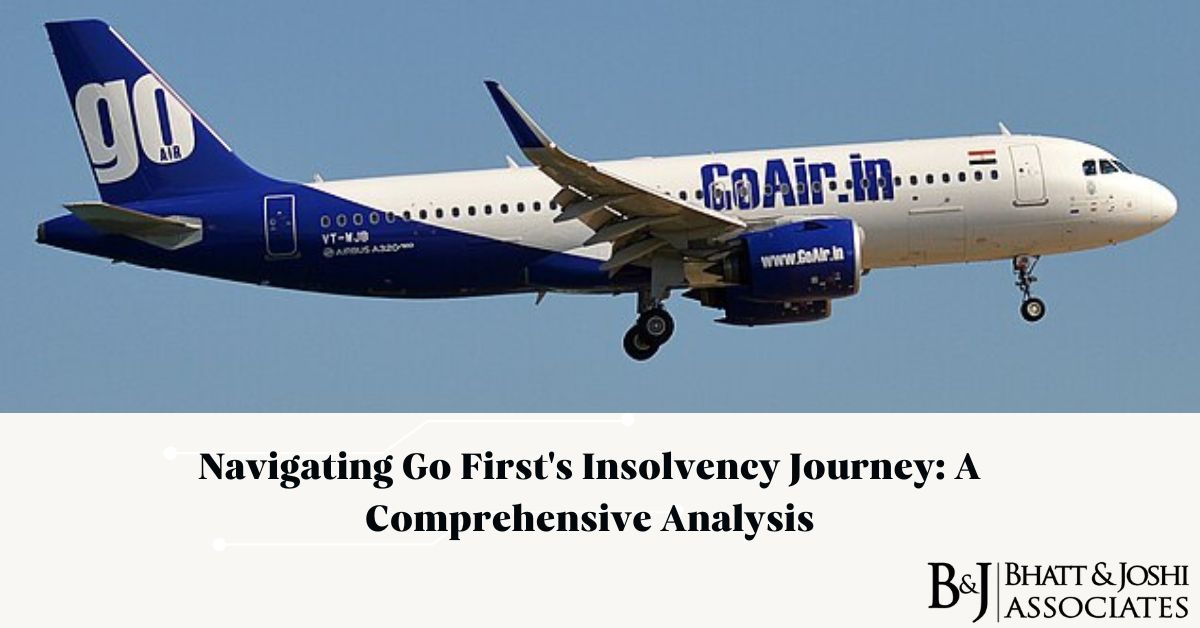
Introduction
Go First, formerly known as GoAir, has found itself embroiled in a protracted insolvency resolution process, overseen by the National Company Law Tribunal (NCLT). This article delves into the intricacies of Go First’s insolvency journey, examining the recent extension granted by the NCLT and its implications.
Background of Go First’s Insolvency
Go First, a prominent player in the Indian aviation industry, faced significant challenges leading to its insolvency proceedings. Factors such as intense competition, rising operational costs, and the impact of the COVID-19 pandemic culminated in the airline’s decision to halt flight operations on May 3, 2023. Subsequently, on May 10, 2023, the NCLT approved Go First’s plea to initiate voluntary insolvency resolution proceedings, marking the beginning of a complex legal and financial restructuring process.
The Role of the National Company Law Tribunal (NCLT)
As the adjudicating authority for corporate insolvency resolution processes in India, the NCLT plays a pivotal role in overseeing Go First’s insolvency proceedings. The tribunal evaluates requests for deadline extensions, considering various factors such as the progress of the resolution process, stakeholder interests, and compliance with legal timelines.
Extension of Deadline by NCLT: A Closer Look at Go First’s Insolvency
The recent extension granted by the NCLT, prolonging the deadline for completing Go First’s insolvency resolution process by another 60 days, underscores the challenges and complexities inherent in resolving the airline’s financial distress. Despite previous deadline extensions, the resolution process continues to face hurdles, necessitating additional time for stakeholders to reach a consensus and formulate a viable resolution plan.
Request for Extension by Resolution Professional (RP)
The resolution professional (RP) appointed to oversee Go First’s insolvency resolution process filed a request with the NCLT seeking an extension of the timeline. The request, grounded in the need for sufficient time to explore potential resolution strategies, address creditor claims, and negotiate with prospective investors, reflects the intricate nature of corporate insolvency proceedings and the importance of ensuring a thorough and transparent resolution process.
Legal Framework: Insolvency & Bankruptcy Code (IBC)
The Insolvency & Bankruptcy Code (IBC) provides the statutory framework governing corporate insolvency resolution processes in India. Section 12(1) of the Code mandates the completion of the corporate insolvency resolution process (CIRP) within 180 days, with a maximum permissible extension period of 330 days, inclusive of litigation time. Compliance with these statutory timelines is essential to safeguard the interests of creditors and facilitate timely resolution of distressed companies.
Implications of Deadline Extensions on Stakeholders
The recurring extensions granted by the NCLT raise pertinent questions regarding the impact on various stakeholders involved in Go First’s insolvency proceedings. Creditors, including financial institutions, operational creditors, and employees, rely on expeditious resolution to recover outstanding dues and mitigate financial losses. Moreover, prolonged uncertainty surrounding the airline’s future adversely affects employee morale, investor confidence, and consumer perception, highlighting the need for timely resolution.
Challenges Faced in Insolvency Resolution
The resolution process of Go First is fraught with numerous challenges, ranging from complex debt restructuring negotiations to regulatory compliance and asset monetization. Stakeholders must navigate these challenges diligently to formulate a comprehensive resolution plan that addresses the interests of all parties involved. Additionally, external factors such as market dynamics, regulatory changes, and macroeconomic conditions further complicate the resolution process, necessitating adaptive strategies and proactive risk management.
Stakeholder Engagement in Go First’s Insolvency: Ensuring Transparency
Effective stakeholder engagement and consensus building are imperative for the success of Go First’s insolvency resolution process. The resolution professional plays a pivotal role in facilitating constructive dialogue among creditors, shareholders, and other stakeholders to identify common objectives, resolve disputes, and forge consensus on the terms of the resolution plan. Transparent communication, mutual trust, and a collaborative approach are essential for fostering a conducive environment for negotiation and decision-making.
Financial and Operational Restructuring
Central to Go First’s insolvency resolution process is the restructuring of its financial and operational framework to restore financial viability and sustainable operations. This entails debt restructuring, capital infusion, cost optimization measures, and strategic realignment to enhance operational efficiency and competitiveness. The resolution plan must strike a balance between addressing immediate financial concerns and laying the foundation for long-term viability and growth.
Impact on the Aviation Industry
The prolonged insolvency proceedings of Go First have broader implications for the Indian aviation industry, including market dynamics, competition, and regulatory oversight. The restructuring of a major player like Go First can influence industry dynamics, route networks, pricing strategies, and consumer choices. Moreover, regulatory authorities closely monitor the resolution process to ensure compliance with aviation regulations, safety standards, and consumer protection measures.
Conclusion: Navigating Go First’s Insolvency Roadmap
As Go First’s insolvency saga unfolds, stakeholders must collaborate diligently to navigate the complexities of the resolution process and chart a sustainable path forward for the airline. The recent extension granted by the NCLT provides a window of opportunity for stakeholders to redouble their efforts, explore innovative solutions, and finalize a viable resolution plan that safeguards the interests of all stakeholders. Effective communication, transparent governance, and proactive risk management are essential to achieving a successful outcome and restoring confidence in the Indian aviation industry.













